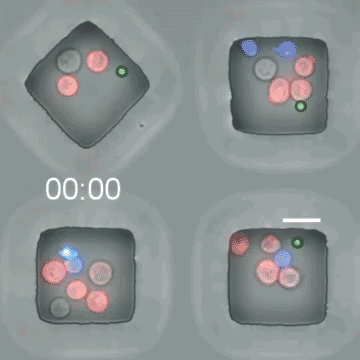University of Houston researchers and their students are developing a new software technology, based on artificial intelligence, for advancing cell-based immunotherapy to treat cancer and other diseases.
CellChorus Inc., a spinoff from the University of Houston, is commercializing the UH-developed Time-lapse Imaging Microscopy In Nanowell Grids™ platform for dynamic single-cell analysis with label-free analysis. Now they've received a $2.5 million grant from the National Center for Advancing Translational Sciences of the National Institutes of Health to fast-track the development of an advanced "label-free" version of this technology in partnership with the University of Houston.

Sample TIMING videos of T cells interacting with tumor cells leading to killing. Scale bar = 20 microns
Badri Roysam, Hugh Roy and Lillie Cranz Cullen University Professor of Electrical and Computer Engineering at the University of Houston, is collaborating with Professor Navin Varadarajan on the project. Varadarjan is an M.D. Anderson Professor, Chemical and Biomolecular Engineering also at UH and co-founder of CellChorus.
"This is an opportunity to leverage artificial intelligence methods for advancing the life sciences," said Roysam. "We are especially excited about its applications to advancing cell-based immunotherapy to treat cancer and other diseases."
TIMING™ is a specialized tool for studying single cells over time. Because it is a video-array-based technology, it observes cell interactions and produces tens of thousands of videos. Analyzing these massive video arrays requires automated computer vision systems.
"By combining AI, microscale manufacturing, and advanced microscopy, the label-free TIMING platform will yield deep insight into cellular behaviors that directly impact human disease and new classes of therapeutics," said Rebecca Berdeaux, chief scientific officer at CellChorus and co-Principal Investigator on the grant. "The generous support of NCATS enables our development of computational tools that will ultimately integrate single-cell dynamic functional analysis of cell behavior with intracellular signaling events.

The goal of the grant, a Small Business Technology Transfer Fast-Track award, is to quantify the behavior of cells without the need to fluorescently stain them. Label-free analysis, or analysis without fluorescent dyes, allows scientists to watch cells in their natural state and gather important information about their movement, interactions and changes. It will also allow them to use selective fluorescent staining to observe new molecules of interest. This is useful in studying diseases like cancer or how cells react to treatments.
The label-free analysis is enabled by new artificial intelligence and machine learning models trained on tens of millions of images of cells and will be optimized for fast, high-throughput single-cell analysis by customers.
This grant is under Award Number 1R42TR005299. The content of this release is solely the responsibility of the authors and does not necessarily represent the official views of the National Institutes of Health.






